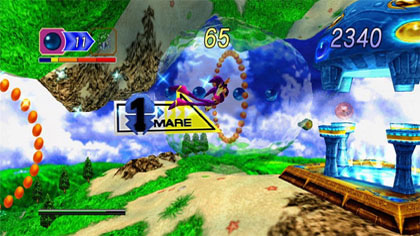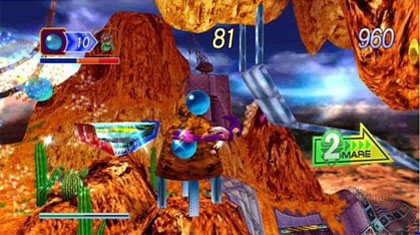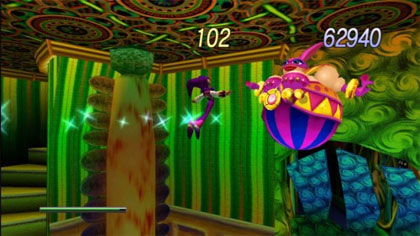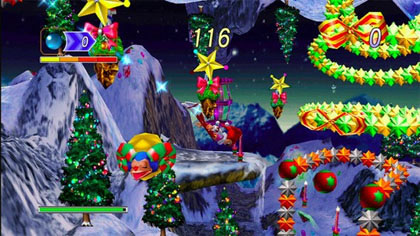- CLASSIC MAGAZINES
- REVIEW CREW
A show recapping what critics thought back
when classic games first came out! - NEXT GENERATION'S BEST & WORST
From the worst 1-star reviews to the best
5-stars can offer, this is Next Generation! - NINTENDO POWER (ARCHIVE)
Experience a variety of shows looking at the
often baffling history of Nintendo Power! - MAGAZINE RETROSPECTIVE
We're looking at the absolutely true history of
some of the most iconic game magazines ever! - SUPER PLAY'S TOP 600
The longest and most ambitious Super NES
countdown on the internet! - THEY SAID WHAT?
Debunking predictions and gossip found
in classic video game magazines! - NEXT GENERATION UNCOVERED
Cyril is back in this spin-off series, featuring the
cover critic review the art of Next Generation! - HARDCORE GAMER MAGAZING (PDF ISSUES)
Download all 36 issues of Hardcore Gamer
Magazine and relive the fun in PDF form!
- REVIEW CREW
- ELECTRONIC GAMING MONTHLY
- ELECTRONIC GAMING MONTHLY RANKS
From Mario to Sonic to Street Fighter, EGM
ranks classic game franchises and consoles! - ELECTRONIC GAMING MONTHLY BEST & WORST
Counting down EGM’s best and worst reviews
going year by year, from 1989 – 2009! - ELECTRONIC GAMING BEST & WORST AWARDS
11-part video series chronicling the ups and
downs of EGM’s Best & Worst Awards!
- ELECTRONIC GAMING MONTHLY RANKS
- GAME HISTORY
- GAME OVER: STORY BREAKDOWNS
Long-running series breaking down game
stories and analyzing their endings! - A BRIEF HISTORY OF GAMING w/ [NAME HERE]
Real history presented in a fun and pithy
format from a variety of game historians! - THE BLACK SHEEP
A series looking back at the black sheep
entries in popular game franchises! - INSTANT EXPERT
Everything you could possibly want to know
about a wide variety of gaming topics! - FREEZE FRAME
When something familiar happens in the games
industry, we're there to take a picture! - I'VE GOT YOUR NUMBER
Learn real video game history through a series
of number-themed episodes, starting at zero! - GREAT MOMENTS IN BAD ACTING
A joyous celebration of some of gaming's
absolute worst voice acting!
- GAME OVER: STORY BREAKDOWNS
- POPULAR SHOWS
- DG NEWS w/ LORNE RISELEY
Newsman Lorne Riseley hosts a regular
series looking at the hottest gaming news! - REVIEW REWIND
Cyril replays a game he reviewed 10+ years
ago to see if he got it right or wrong! - ON-RUNNING FEUDS
Defunct Games' longest-running show, with
editorials, observations and other fun oddities! - DEFUNCT GAMES QUIZ (ARCHIVE)
From online quizzes to game shows, we're
putting your video game knowledge to the test!- QUIZ: ONLINE PASS
Take a weekly quiz to see how well you know
the news and current gaming events! - QUIZ: KNOW THE GAME
One-on-one quiz show where contestants
find out if they actually know classic games! - QUIZ: THE LEADERBOARD
Can you guess the game based on the classic
review? Find out with The Leaderboard!
- QUIZ: ONLINE PASS
- DEFUNCT GAMES VS.
Cyril and the Defunct Games staff isn't afraid
to choose their favorite games and more! - CYRIL READS WORLDS OF POWER
Defunct Games recreates classic game
novelizations through the audio book format!
- DG NEWS w/ LORNE RISELEY
- COMEDY
- GAME EXPECTANCY
How long will your favorite hero live? We crunch
the numbers in this series about dying! - VIDEO GAME ADVICE
Famous game characters answer real personal
advice questions with a humorous slant! - FAKE GAMES: GUERILLA SCRAPBOOK
A long-running series about fake games and
the people who love them (covers included)! - WORST GAME EVER
A contest that attempts to create the worst
video game ever made, complete with covers! - LEVEL 1 STORIES
Literature based on the first stages of some
of your favorite classic video games! - THE COVER CRITIC
One of Defunct Games' earliest shows, Cover
Critic digs up some of the worst box art ever! - COMMERCIAL BREAK
Take a trip through some of the best and
worst video game advertisements of all time! - COMIC BOOK MODS
You've never seen comics like this before.
A curious mix of rewritten video game comics!
- GAME EXPECTANCY
- SERIES ARCHIVE
- NINTENDO SWITCH ONLINE ARCHIVE
A regularly-updated list of every Nintendo
Switch Online release, plus links to review! - PLAYSTATION PLUS CLASSIC ARCHIVE
A comprehensive list of every PlayStation
Plus classic release, including links! - RETRO-BIT PUBLISHING ARCHIVE
A regularly-updated list of every Retro-Bit
game released! - REVIEW MARATHONS w/ ADAM WALLACE
Join critic Adam Wallace as he takes us on a
classic review marathon with different themes!- DEFUNCT GAMES GOLF CLUB
Adam Wallace takes to the links to slice his way
through 72 classic golf game reviews! - 007 IN PIXELS
Adam Wallace takes on the world's greatest spy
as he reviews 15 weeks of James Bond games! - A SALUTE TO VAMPIRES
Adam Wallace is sinking his teeth into a series
covering Castlevania, BloodRayne and more! - CAPCOM'S CURSE
Adam Wallace is celebrating 13 days of Halloween
with a line-up of Capcom's scariest games! - THE FALL OF SUPERMAN
Adam Wallace is a man of steel for playing
some of the absolute worst Superman games! - THE 31 GAMES OF HALLOWEEN
Adam Wallace spends every day of October afraid
as he reviews some of the scariest games ever! - 12 WEEKS OF STAR TREK
Adam Wallace boldly goes where no critic has
gone before in this Star Trek marathon!
- DEFUNCT GAMES GOLF CLUB
- DAYS OF CHRISTMAS (ARCHIVE)
Annual holiday series with themed-episodes
that date all the way back to 2001!- 2015: 30 Ridiculous Retro Rumors
- 2014: 29 Magazines of Christmas
- 2013: 29 Questionable Power-Ups of Christmas
- 2012: 34 Theme Songs of Christmas
- 2011: 32 Game Endings of Christmas
- 2010: 31 Bonus Levels of Christmas
- 2009: 30 Genres of Christmas
- 2008: 29 Controls of Christmas
- 2007: 34 Cliches of Christmas
- 2006: 33 Consoles of Christmas
- 2005: 32 Articles of Christmas
- 2004: 31 Websites of Christmas
- 2003: 29 Issues of Christmas
- 2002: 28 Years of Christmas
- 2001: 33 Days of Christmas
- NINTENDO SWITCH ONLINE ARCHIVE
- REVIEW ARCHIVE
- FULL ARCHIVE
NiGHTS into Dreams
After catching lightning in a bottle with Sonic the Hedgehog, Sega intended NiGHTS into Dreams to be the next big thing for their fledgling Saturn. Sega was so confident in its success that they decided to bundle it with a brand new analog stick-enhanced controller. Forget about the Nintendo 64 and Sony PlayStation, this was going to be the game that took the 32-bit system to the next level.
Unfortunately, NiGHTS into Dreams didn't quite live up to Sega's expectations. For years the game seemed like it was lost to time; a relic of the past that would never again see the light of day. Despite game journalists like me singing its praises, Sega clearly wasn't interested in keeping this franchise alive. The one glimmer of hope was the PlayStation 2 port, and even that was confined to a Japan-only release.

Just as it looked like Sega was done with NiGHTS, the company surprised everybody with a Wii sequel. And now, five short years later, they're finally getting around to re-releasing this long-forgotten gem on the PlayStation 3 and Xbox 360. This will be many gamers first time with the much hyped platformer. I have a hunch that a lot of people are going to be left scratching their heads wondering why this was a big deal.
NiGHTS is one of those games that purposely keeps you at arm's length. No matter how hard you try to get close, it will thwart your advances at every turn. It refuses to play by convention to the point of frustration. And yet, despite its deliberately impenetrable exterior, it turns out to be an incredibly moving experience with a lot of truly great ideas you don't often see in this style of game. Sadly, few will see what makes NiGHTS into Dreams so memorable.
You play either a young boy (Elliot) or girl (Claris) as they explore a 3D dreamscape. All of their orbs are stolen at the beginning of each stage, so it's up to them to traverse the area and regain what they lost. Thankfully they aren't alone. By going to the temple, Elliot and Claris will be magically transformed into a third character, a flying jester named Nights.

Although it sounds needlessly convoluted, the basic goal is the same from level to level. As Nights, you fly around a set course collecting blue orbs, defeating enemies and spinning through hoops. Eventually you'll come across a floating platform that will only be destroyed if you have enough blue orbs. Once you've collected enough orbs and destroyed the floating platform, you're free to speed back to the temple and move on to the next part of the level. Each stage has four different sections, each with their own set paths.
While this may sound easy, the rub is that you only have two minutes to complete each stage. Sometimes it will take two or three laps around the world to collect enough blue orbs to complete the stage, which means you'll be fighting the clock to get back to the temple. Run out of time and you'll revert back to the teenager you started as.
Once you've completed all four parts of the stage, you'll be thrown into a large arena where you'll take on a boss. Unfortunately, this is where the game starts to break down. Each boss is different, which means that you'll have to figure out their weakness and defeat them in less than two minutes. Fail and you go all the way back to the start of that stage. Even when I knew how to defeat the boss, I still found myself having to replay levels multiple times.
The difficulty spike is even more jarring when you discover how easy the regular stages are. The bad guys are usually pretty easy to avoid and there's nothing challenging about collecting blue orbs. Even if you run out of time, you are barely penalized for your mistake. We go from a peaceful zen playground to a frustratingly vague boss fight. This is the kind of thing Sega could have fixed by adding a checkpoint, but the emphasis here was making the game look better, not play better.

Even if you can get past the spikes in difficulty and simplistic gameplay, you'll still hit a wall without knowing. You don't unlock all of the levels by simply beating bosses; some levels will only be opened by earning certain rankings. You'll see locked levels, but there are no clues on how to open them. These days, people can turn to the internet for the quick answers, but I'm dumbfounded by how bad the user interface is in this 1996 Saturn port.
Once you've made your way through the entire dream, you'll unlock one of the coolest bonuses of all time. It's Christmas NiGHTS, a holiday-themed expansion pack. Originally distributed in partnership with a magazine company, Christmas NiGHTS offers a plethora of snowy mountains and holiday bosses to fight. It also brings Sonic the Hedgehog into the mix. This is an especially good deal considering the game was never sold at retail and is surprisingly rare these days.

The graphics are good, though certainly outdated. The HD models aren't very realistic, often resembling toys. The worlds are full of pop-ins, even though the land around them isn't that expansive. Considering this was a Sega Saturn game (and not a Dreamcast game, like all of Sega's other recent re-releases), NiGHTS' presentation is commendable. Even when you're baffled by the boss fights, the actual art design is endearing and full of whimsy. The dreamscape world they've created is beautiful and diverse, but part of me would love to see these areas redrawn using the full power of the PlayStation 3's hardware.
NiGHTS into Dreams is not answer to Sega's Super Mario 64; it's not a game that will change the way you look at video games. It's an interesting take on a platformer with a truly unique sense of style. The price is right, even if some of the design decisions seem archaic by today's standards. Whatever you do, don't sleep through NiGHTS into Dreams.
HOME |
CONTACT |
NOW HIRING |
WHAT IS DEFUNCT GAMES? |
NINTENDO SWITCH ONLINE |
RETRO-BIT PUBLISHING
Retro-Bit |
Switch Planet |
The Halcyon Show |
Same Name, Different Game |
Dragnix |
Press the Buttons
Game Zone Online | Hardcore Gamer | The Dreamcast Junkyard | Video Game Blogger
Dr Strife | Games For Lunch | Mondo Cool Cast | Boxed Pixels | Sega CD Universe | Gaming Trend
Game Zone Online | Hardcore Gamer | The Dreamcast Junkyard | Video Game Blogger
Dr Strife | Games For Lunch | Mondo Cool Cast | Boxed Pixels | Sega CD Universe | Gaming Trend
Copyright © 2001-2025 Defunct Games
All rights reserved. All trademarks are properties of their respective owners.
All rights reserved. All trademarks are properties of their respective owners.





























